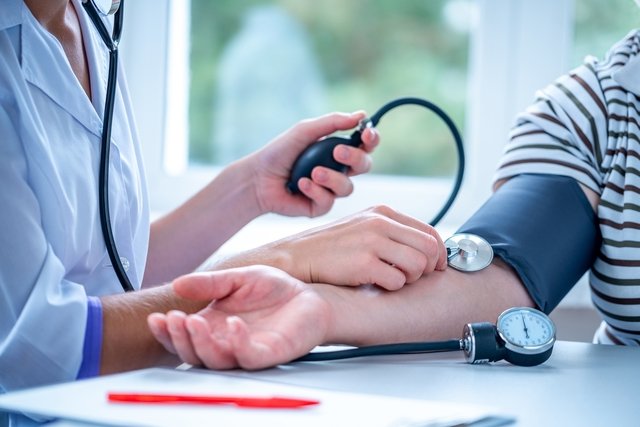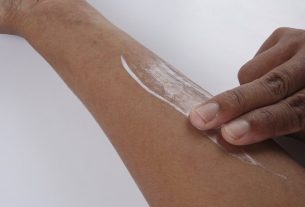Blood pressure is the value that represents the force that the blood exerts against the blood vessels as it is pumped by the heart and circulates through the body, and can be measured in the doctor’s office, at home or in health centers or pharmacies.
The pressure considered normal is one that is close to 120×80 mmHg. A person is considered hypertensive (high blood pressure) when their pressure is 140×90 mmHg measured in the office, and when it is below 90×60 mmHg it is considered hypotension (low blood pressure). See the reference values for high blood pressure.
Manual techniques can be used to measure blood pressure, such as a sphygmomanometer or digital devices, which are sold in pharmacies and some medical stores and are easy to use at home. Watch the video with Dr. Ronaldo Gismondi on how to measure blood pressure correctly:
Blood pressure should not be measured with your fingers or wristwatch, as this method only helps measure heart rate, which is the number of heart beats per minute. See also how to assess your heart rate correctly.
When to measure blood pressure
Blood pressure should ideally be measured:
- In the morning and before taking any medicine;
- After urinating and resting for at least 5 minutes;
- Sitting with your arm relaxed.
Furthermore, it is very important not to drink coffee, alcohol or smoke 30 minutes beforehand, as well as to maintain normal breathing, not cross your legs and avoid talking during the measurement.
How to measure blood pressure
The way in which blood pressure is measured may vary depending on the device used. It is important that the cuff fits your arm or wrist and is not too loose or tight. In the case of obese people, the alternative for measuring blood pressure may be by placing the cuff on the forearm.
Some devices can also measure blood pressure in the fingers, however they are not reliable and, therefore, should not be used in more sensitive situations, as blood pressure in the extremities is different from the pressure in the rest of the body.
Furthermore, measuring blood pressure in the thigh or calf is only recommended when the person has some contraindication to measuring blood pressure in the upper limbs, such as having some type of catheter or having undergone surgery to remove lymph nodes.
1. With wrist device
To measure blood pressure alone using your wrist, you must place the device on your left wrist with the monitor facing inward, resting your elbow on the table, with your palm facing up and waiting for the device to read your blood pressure. .
It is important that the fist is positioned at heart level so that the result is more reliable.
This device should not be used in all cases, such as in the case of atherosclerosis. Therefore, before purchasing a device, you should seek advice from a pharmacist or nurse.
2. With the digital device
To measure blood pressure with a digital device, place the device cuff 2 to 3 cm above the crook of your arm, tightening it so that the cuff wire is above your arm.
Then, with your elbow resting on the table and your palm facing up, turn on the device and wait until it reads your blood pressure.
There are digital devices with a pump, so in these cases, to inflate the cuff, you must press the pump to 180 mmHg, then wait for the device to read your blood pressure. If the arm is very thick or very thin, you may need to use a larger or smaller brace.
3. With the sphygmomanometer

To measure blood pressure manually with a sphygmomanometer and stethoscope, you must:
- Try to feel the pulse in the bend of the left arm, placing the head of the stethoscope in that location;
- Place the device clamp 2 to 3 cm above the bend of the same arm, tightening it, so that the armband wire is above the arm;
- Close the pump valve and with the stethoscope in your ears, inflate the cuff to 20 or 30 mmHg for the estimated BP level or until you no longer hear sounds in the stethoscope;
- Open valve slowly, about 2 mmHg per second, while looking at the pressure gauge. The moment you hear the first sound, the pressure indicated on the manometer must be recorded, as it is the first value of blood pressure or systolic pressure;
- Continue to deflate the cuff slowly until you no longer hear sound. When you stop hearing sounds, you should record the pressure indicated on the manometer, as it is the second value of blood pressure or diastolic pressure;
- Continue listening with the stethoscope until it reaches approximately 20 to 30 mmHg below the last sound heard;
- Join the first value with the second to obtain blood pressure. For example, when the first value is 130 mmHg and the second is 70 mmHg, the blood pressure is 13 x 7.
It is recommended to take 3 blood pressure measurements, with a 1-minute interval between them, and use the average of the last two measurements to obtain the blood pressure value.
If there is a difference of more than 10 mmHg between measurements, additional blood pressure measurements must be taken.
Measuring blood pressure with a sphygmomanometer is not simple and can result in incorrect values. For this reason, this type of measurement is often only carried out by healthcare professionals, such as nurses, doctors or pharmacists. Learn more about the sphygmomanometer and how to use it correctly.
4. With MAPA
Blood pressure measurement with ABPM (Ambulatory Blood Pressure Monitoring) is done with a device, which has an armband connected to an electronic monitor, worn for 24 hours or more, during usual day-to-day activities and when the person is sleeping.
This exam is carried out to diagnose systemic arterial hypertension, nocturnal hypertension, masked hypertension, white coat hypertension or postural hypotension, for example, or to assess whether the treatment of high blood pressure is being effective. See how the ABPM is performed and the care taken during the exam.
5. With HBPM
HBPM (Home Blood Pressure Monitoring) is a diary kept by the person, recording blood pressure measurements with a wrist device, digital device or sphygmomanometer, for 4 to 6 days.
This type of monitoring begins in the doctor’s office, with 3 blood pressure measurements, which must then be taken at home, with 3 measurements in the morning and 3 measurements at night, for 4, 5 or 6 days.
The results must be interpreted by the cardiologist, and high blood pressure is considered when it is greater than or equal to 130 x 80 mmHg.
It is important that blood pressure is measured before a meal or before using antihypertensive medication and also following other precautions so that it is measured correctly.
Online blood pressure calculator
To find out if your blood pressure is normal or high, please enter the data into our calculator:
The blood pressure calculator is only a guidance tool, not serving as a diagnosis or replacing a consultation with a cardiologist.
Care for measuring blood pressure
To measure blood pressure correctly, some precautions are important, such as:
- Being in a calm and comfortable environment;
- Empty the bladder before measuring pressure;
- Measure blood pressure after 5 minutes of rest;
- Take 3 consecutive blood pressure measurements, with an interval of 1 minute between them;
- Do not talk or move during blood pressure measurement;
- Position the arm supported at heart level with the palm facing upwards;
- Do not be dressed in blouses or shirts that are tight on the arms;
- Do not drink alcoholic or caffeinated drinks and do not smoke at least 30 minutes before measuring your blood pressure;
- Do not exercise in the previous 90 minutes.
Furthermore, the person must be sitting, with legs uncrossed, feet flat on the floor and back relaxed and supported on the chair.
These precautions are important to ensure that blood pressure is measured correctly.

Sign up for our newsletter and stay up to date with exclusive news
that can transform your routine!
Warning: Undefined array key "title" in /home/storelat/public_html/wp-content/plugins/link-whisper-premium/templates/frontend/related-posts.php on line 12
Warning: Undefined array key "title_tag" in /home/storelat/public_html/wp-content/plugins/link-whisper-premium/templates/frontend/related-posts.php on line 13



